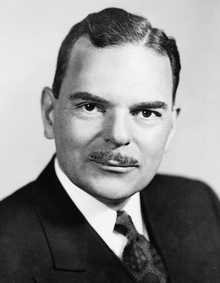Texas Regulars
| | |||||||||||||||||||||||||||||||||||||||
| |||||||||||||||||||||||||||||||||||||||
| |||||||||||||||||||||||||||||||||||||||
|
| |||||||||||||||||||||||||||||||||||||||
| Presidential election results map. Red denotes states won by Dewey/Bricker, Blue denotes those won by Roosevelt/Truman. Numbers indicate the number of electoral votes allotted to each state. | |||||||||||||||||||||||||||||||||||||||
| |||||||||||||||||||||||||||||||||||||||
The Texas Regulars was a group based in Texas which was formed in 1944 to deny Franklin D. Roosevelt a majority of the Electoral College in the 1944 presidential election.
By the 1940s, Texas conservative Democrats were irritated with Roosevelt and his New Deal and they were also unhappy about the Supreme Court striking down the segregated primary in Smith v. Allwright. They planned to gain control of the nominating convention and select a slate of electors who would not vote for Roosevelt. Texas Regulars supporters included Congressman Martin Dies Jr., former Texas governor Dan Moody, and Senator W. Lee O'Daniel.
The Texas Regulars won the first convention, but they then lost the second convention. This led them to form their own ticket which did not field a candidate. On election day, they finished third both in Texas and in the national popular vote, with 135,439 votes (0.3% of the vote nationally, and 11.8% of the vote in Texas).[1] They won a majority in only Washington County, Texas. Roosevelt easily carried Texas with 71.4% of the statewide vote and won national re-election with 432 of 531 Electoral Votes.
The Texas Regulars disbanded soon afterward, but many of them went on to support the Dixiecrat candidacy of Strom Thurmond in the 1948 presidential election.
(small).jpg)

